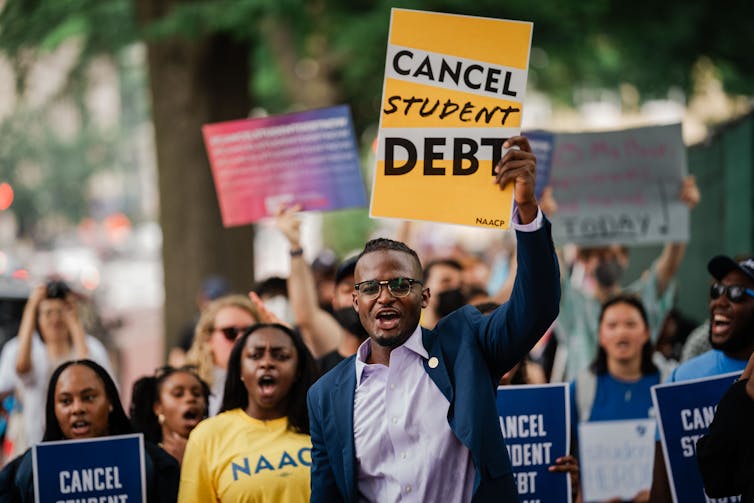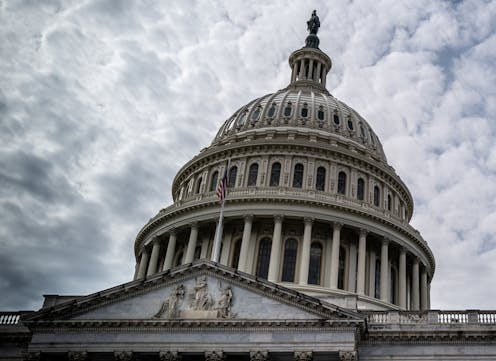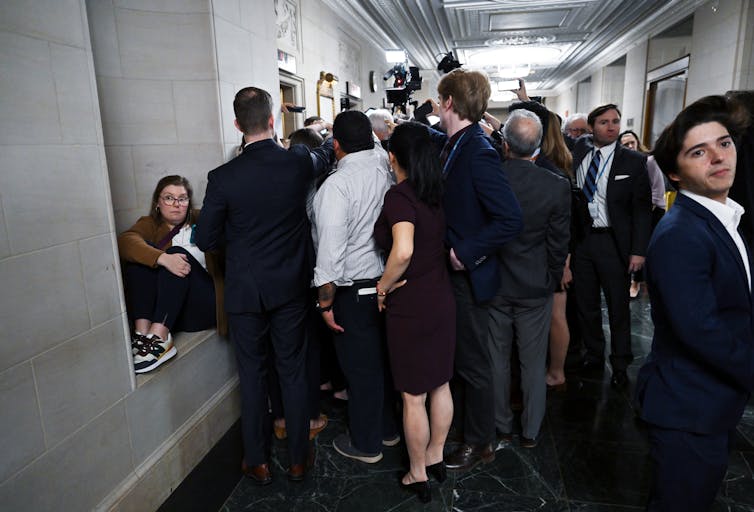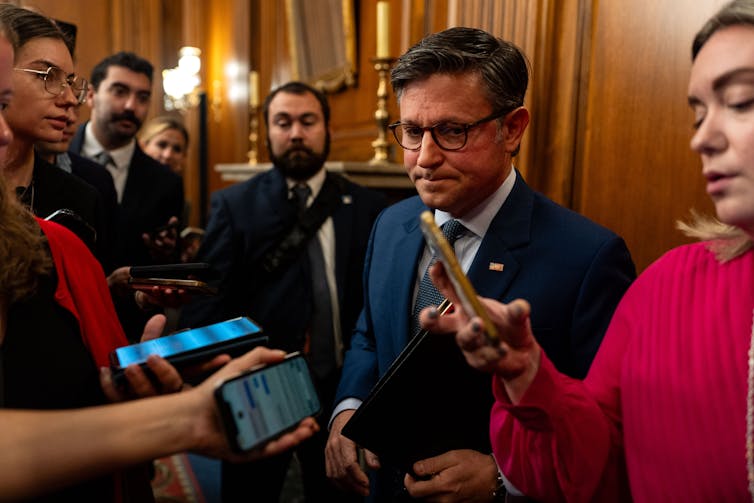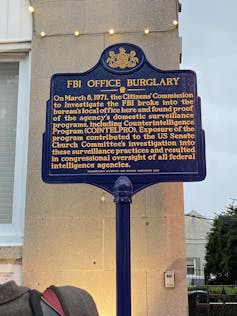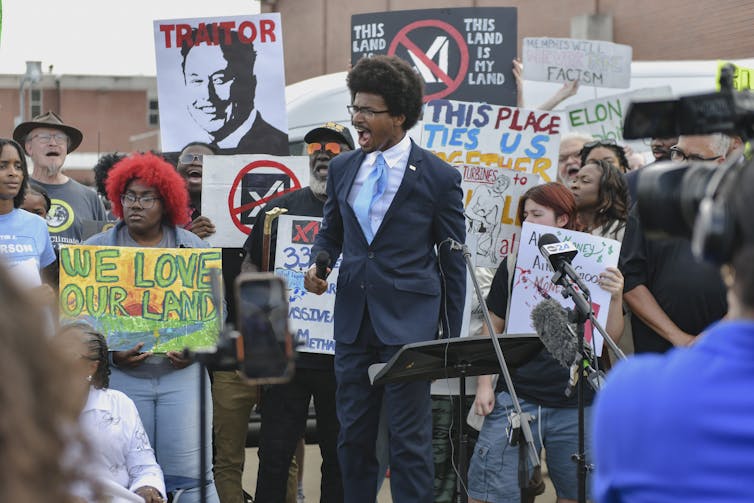Source: The Conversation – USA – By Charlotte Oliver, Extension Associate Professor, Colorado State University
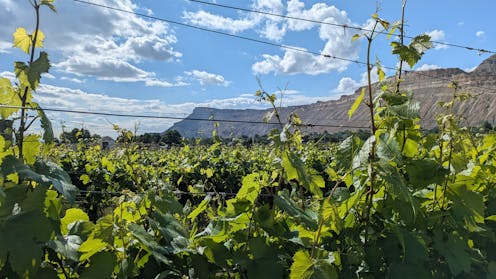
Grape phylloxera, or Daktulosphaira vitifoliae, is an aphidlike insect that attacks grapevines with devastating effects. In Colorado, where wine is an estimated US$3.9 billion dollar industry, phylloxera poses a significant threat.
In 2015, several vineyards in the Grand Valley American Viticultural Area on Colorado’s Western Slope observed that groups of their vines were not thriving. The vines were yellowing and producing limited fruit. All the normal issues, such as nutritional deficiencies and irrigation problems, were investigated and nothing turned up.
So, in 2016, two Colorado State University researchers began surveying vineyards in Mesa County and found the industry’s worst nightmare – phylloxera, which had infested the roots in several local vineyards.
The pair expanded their survey and covered more than 350 vineyard acres across Mesa, Delta and Montezuma counties, where wine grapes are grown. Phylloxera was found in both Mesa and Delta counties in 18 vineyards for a total of 34 scattered acres. The phylloxera wasn’t centralized, which made controlling its spread complicated.
In response to the researchers’ findings, the Colorado Wine Industry Development Board and the Colorado Association for Viticulture and Enology began an education campaign in 2017 to minimize visitors to vineyards and help vineyards manage soil movement, the primary mode of phylloxera spread.
As the viticulture extension specialist at Colorado State University, I spend a lot of time helping Coloradans work with their grapevines. In 2024, I took over the research at Colorado State University on the phylloxera infestation that is still active nine years after it was discovered. I plan to continue tracking phylloxera’s spread and training producers on what to do when, not if, this pest appears in their vineyard.
What is phylloxera?

Bildagentur-online/Getty Images
Phylloxera have two discrete forms during their life cycle: an above-ground, winged form called alates and a below-ground, wingless, root-feeding form called radicoles.
The above-ground form of the insect causes galls, which are lumpy swellings on the grape leaves, that generally have limited impact on the vine’s health.
However, the below-ground insects that feed on the vine’s roots cause severe damage. The roots are the vine’s main tool for foraging for nutrients and water, so when they are compromised the vine starts to suffer and eventually dies four to seven years after being infected. Sometimes phylloxera’s infestation looks like a lack of nutrition or water, so knowing what is wrong with the vines can require a lot of searching and testing. The real issue is that as the vine declines, it also stops producing a commercially viable quantity of fruit, which is 2.5-4 tons per acre. No fruit means no wine, so the vines have to be removed.
Managing the ‘wine blight’
Grapevines, like a lot of other perennial crops, including peaches and apples, are usually grafted, which is when the top of one plant and the roots of another plant are combined to make one continuous plant. Usually, the grafting is to change something about the physicality of the plant, such as making it bigger or smaller. With grapes, the main reason to graft is to protect the vine from damage from a single pest – grape phylloxera.
There are alternatives such as insecticides, but they are Band-Aids, because insecticides suppress only the pest. Grape roots, and the phylloxera on them, can go far deeper into the soil than the soil insecticide treatments, and some of the treatments to the leaves can be damaging to honeybees.
Another potential solution is using modern varieties of grapes that were bred by crossing native North American grapes with the standard European wine grape. By adding in North American grapes, the new varieties are more tolerant of the phylloxera and can handle some damage. The issue with these varieties, such as Chambourcin and Aromella, is that consumers have never heard of them, which is a major factor when people buy wine. These varieties also have more Concord grape flavors that are less common to wine drinkers outside of the East Coast of the U.S.
Globe-trotting pests
Phylloxera is native to the East Coast and Midwestern United States, but now it’s found in all grape-growing regions worldwide.
In the late 1800s, phylloxera started making its way around the world. Phylloxera can fly when it is in its above-ground life cycle, but the below-ground insects can be spread any time soil is moved. It hitched a ride to France in the early 1860s on North American grape plants that were being imported to help with powdery mildew, which is the most economically damaging fungal disease of grapes. Powdery mildew, or Erysiphe necator, can attack all growing tissues of a vine, including blooms, leaves and shoots, and control can account for approximately 37% of gross grape production cost.
Over the course of three decades after phylloxera was introduced to France, it caused approximately 2.5 million acres of vines to be replaced.
Once it crossed the Atlantic, phylloxera was flying over borders and road-tripping from vineyard to vineyard on workers’ shoes and tractors. By the beginning of the 1900s, phylloxera had spread throughout France, Portugal, Germany and then Spain and established itself as a permanent problem. The European varieties of grapes had no resistance to phylloxera, and the insects found ways to evade chemical management, making yearly insecticide applications a necessity.

Courtesy of Charlotte Oliver
While phylloxera is native to the U.S., until recently, there were several states that did not have it, including Colorado, Oregon and Washington.
Colorado’s 50-year-old wine grape industry benefited from the absence of phylloxera. Vineyards owners planted mostly self-rooted European variety vines starting around the mid-1980s. Self-rooted vines are not grafted, which means that a Chardonnay vine was Chardonnay both above and below ground.
Currently, there are areas in multiple countries such as Australia and China, and certain states such as Washington, where phylloxera is present but well contained through quarantine. However, there are concerns for the future. Computer modeling has offered ideas about the future expansion of phylloxera’s survival range on both a regional and global scale.
What does the future hold?
In a 2019 survey by the same research team, more phylloxera was found in vineyards in Delta County as well as a new vineyard outside of Denver. Currently, many Colorado vineyards are in the middle of overhauling their vineyards. The spread of phylloxera as well as the frequency of freezes has led to extensive death in vineyards across the Western Slope.
The percentage of acreage planted with nongrafted, non-European grapes has increased to 25% in recent years, according to results from statewide surveys. Approximately 30% of the replaced vineyards were with new modern varieties, and the rest were replaced with grafted European varieties.
While the European grafted vine may provide a higher-priced fruit due to market demand, the modern varieties have a lot of appeal. Since the vines are more phylloxera tolerant, they do not have to be grafted, so they can easily be recovered when a harsh fall freeze happens.
While the Colorado wine industry has accepted that phylloxera is here to stay, expanded surveys are needed to better understand how far this pest has spread, especially in the more isolated areas of the West Elks American Viticultural Area, in Delta County, the southwest corner of Colorado, in Montezuma County, and in Fremont and Pueblo counties.
Additionally, future phylloxera spread may be better estimated by studying soil texture and temperature, which has been done in models created by Washington State University. Phylloxera may be less likely to survive in certain areas of Colorado. If those areas are also suitable for grape production, it could help direct the locations of future plantings, especially of European varieties.
Read more of our stories about Colorado.
![]()
Charlotte Oliver does not work for, consult, own shares in or receive funding from any company or organization that would benefit from this article, and has disclosed no relevant affiliations beyond their academic appointment.
– ref. How a devastating grape pest is reshaping vineyards across Colorado’s Western Slope – https://theconversation.com/how-a-devastating-grape-pest-is-reshaping-vineyards-across-colorados-western-slope-263088











